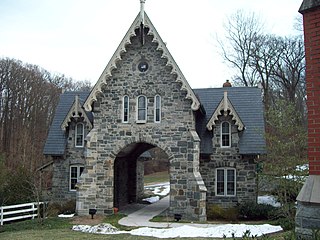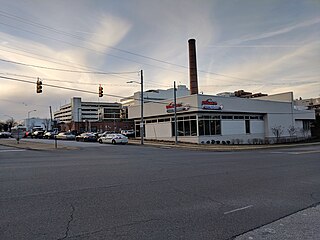
Reisterstown is an unincorporated community and census-designated place in Baltimore and Carroll counties, Maryland, United States. As of the 2010 census, it had a population of 25,968.

Beltsville is a census-designated place (CDP) in northern Prince George's County, Maryland, United States. The community was named for Truman Belt, a local landowner. The 2020 census counted 20,133 residents. Beltsville includes the unincorporated community of Vansville.

Druid Hill Park is a 745-acre (3.01 km2) urban park in northwest Baltimore, Maryland. Its boundaries are marked by Druid Park Drive (north), Swann Drive and Reisterstown Road, and the Jones Falls Expressway / Interstate 83 (east).

Bolton Hill is a neighborhood in Baltimore, Maryland, with 20 blocks of mostly preserved buildings from the late 19th century. It is listed on the National Register of Historic Places, preserved as a Baltimore City Historic District, and included within the boundaries of Baltimore National Heritage Area. The neighborhood is bounded by North Avenue, Mount Royal Avenue, Cathedral Street, Dolphin Street, and Eutaw Place. Bolton Hill is a largely residential neighborhood with three-story row houses with red brick, white marble steps, and high ceilings. There are also larger more ornate originally single-family houses, many houses of worship, parks, monuments, and a few large apartment buildings. Many significant residents have lived in the neighborhood, including F. Scott Fitzgerald, Woodrow Wilson, the Cone sisters, and Florence Rena Sabin.
Joppa is a former colonial town and current planning region of Harford County, Maryland, United States. Joppa was founded as a British settlement on the Gunpowder River in 1707 and designated as the third county seat of Baltimore County in 1712. The original boundaries of Baltimore County were defined in 1659 and contained all of modern day Baltimore County, Baltimore City, Harford and Cecil counties and parts of Howard, Carroll, Anne Arundel and Kent counties. The settlement was named for the Biblical town of Jaffa in the ancient Holy Land of modern-day Israel. Joppa's harbor began to silt in due to clearcutting and farming upriver and coupled with multiple outbreaks of diseases such as smallpox and malaria, the county seat was moved to the growing, deep water port of Baltimore in 1768. Joppa's population would decline rapidly thereafter and businesses left for more prosperous environments in the new Baltimore Town.

Johns Hopkins Bayview Medical Center is the teaching hospital trauma center, neonatal intensive care unit, geriatrics center, and is home to the Johns Hopkins Burn Center, the only adult burn trauma in Maryland, containing about 420 beds. Located in southeast Baltimore City, Maryland, along Eastern Avenue near Bayview Boulevard, it is part of the Johns Hopkins Health System and named after its close proximity to the Chesapeake Bay. Founded in 1773 as an almshouse, it was relocated several times until its now present location in 1866. In 1925, it transitioned into several municipal hospitals, which transferred ownership to Johns Hopkins Hospital in 1984.

Coppin Heights/Ash-Co-East is a predominately African-American working-class neighborhood in West Baltimore, Maryland. It is located south of North Avenue, west of N Smallwood Street, east of N Dukeland Street, and approximately north of the railroad tracks. The community was originally called "Ash Co. East" (Ash-Co-East). In 1989, it was renamed Coppin Heights. The name "Coppin" is from Fanny Jackson Coppin a pioneering black educator. It is unknown what "Ash Co. East" means.

John Rudolph Niernsee was an American architect. He served as the head architect for the Baltimore and Ohio Railroad. Rudolph also largely contributed to the design and construction of the South Carolina State House located in Columbia, South Carolina. Along with his partner, James Crawford Neilson, Rudolph established the standard for professional design and construction of public works projects within Baltimore and across different states in the United States.

Mosher is a neighborhood in the western part of Baltimore, Maryland. Its boundaries are the north side of Edmondson Avenue, the west side of Braddish Avenue, the east side of Poplar Grove, and the south side of Riggs Avenue. The neighborhood lies in the vicinity of Walbrook Junction, Coppin State University, Sandtown-Winchester, and Edmondson Village. Mosher is one of several neighborhoods that resisted the development of the "Road to Nowhere", now designated as US 40, along the Franklin Avenue corridor. The area was historically segregated, and largely occupied by European Americans, but transitioned during the early 1950s to become a predominantly African American area.
Lutheran Hospital may refer to:

University of Maryland Rehabilitation & Orthopaedic Institute is a rehabilitation hospital located along the border of the Forest Park neighborhood of northwest Baltimore City and Woodlawn in Maryland. It lies on and is incorporated into the historic hospital building and grounds of the former James Lawrence Kernan Hospital. The hospital is now part of the University of Maryland Medical System, on the campus of the University of Maryland at Baltimore.

Young Men's and Young Women's Hebrew Association Building, also known as the Jewish Community Center, is a historic building located in central Baltimore, Maryland, United States. It is a three-story, flat-roofed, rectangular-shaped Flemish bond brick structure completed in 1930. The exterior features Moorish and Jewish motifs, such as the Star of David. It was designed by Baltimore architect Joseph Evans Sperry. It is now an apartment building. The establishment of the joining YM/YWHA building was a notable example of an attempt to bridge the divide between uptown Baltimore's prosperous German Jews and East Baltimore's impoverished Eastern European and Russian Jews. The association building was constructed midway between uptown and East Baltimore to symbolize this coming together of the two halves of Baltimore's Jewish community.

"Mount Winans" is a mixed-use residential, commercial and industrial neighborhood in the southwestern area of the City of Baltimore in Maryland. Its north, south and east boundaries are marked by the various lines of track of the CSX Railroad. In addition, Hollins Ferry Road running to the south towards suburban Baltimore County in the southwest and further connecting with adjacent Anne Arundel County to the southeast, draws its western boundary.

Edward Lupus (1834–1877) was a German-born American architect. Born in 1834 in the Grand Duchy of Hesse, he arrived in Baltimore at age 19 on November 8, 1853, from Bremen. At the time of his immigration to the United States, he reported his profession as a joiner. By 1860, Edward Lupus had married and lived at 16 West Baltimore Street with his wife, Sophia Lupus, their children, Rudolph and Charles, as well as an older Rudolph Lupus, a watchmaker and likely relative of Edward, and Rudolph’s wife, Louisa Lupus. The two continued to share both residences and offices throughout the 1860s.
Born in Massachusetts in March 1844, Henry Albert Roby, also known as Harry A. Roby, joined the 1st Maryland Regiment of the Confederate Army at age 18, fighting in the Battle of Gettysburg and serving through the end of the Civil War. Roby began work as a draftsman in 1868 at 891 Park Avenue, his mother's home since at least 1865. By 1870, Roby is identified in directories as an architect with an office at 155 Park Avenue and in 1871 Edward Lupus and Roby began a partnership that would continue for six years, up until Lupus’ death in 1877. Roby continued to work as an architect in Baltimore through at least 1880, moving his office from 49 Lexington Street to 49 St. Paul Street in 1879 while residing at 197 Park Avenue.

Baltimore Heritage is an American nonprofit historic-preservation organization headquartered in Baltimore, Maryland.

The Sheppard and Enoch Pratt Hospital, known to many simply as Sheppard Pratt, is a psychiatric hospital located in Towson, a northern suburb of Baltimore, Maryland. Founded in 1853, it is one of the oldest private psychiatric hospitals in the nation. Its original buildings, designed by architect Calvert Vaux, and its Gothic gatehouse, built in 1860 to a design by Thomas and James Dixon, were designated a National Historic Landmark in 1971.

Charles E. Miller (1902–1979) was an American politician and businessman in Howard County, Maryland

Zion Lutheran Church, also known as the Zion Church of the City of Baltimore, is a historic Evangelical Lutheran church located in downtown Baltimore, Maryland, United States, founded 1755.

Levindale is a neighborhood in northwest Baltimore which includes Sinai Hospital, the Levindale Hebrew Geriatric Center and Hospital, and a small number of detached homes and apartment buildings towards its south.






















